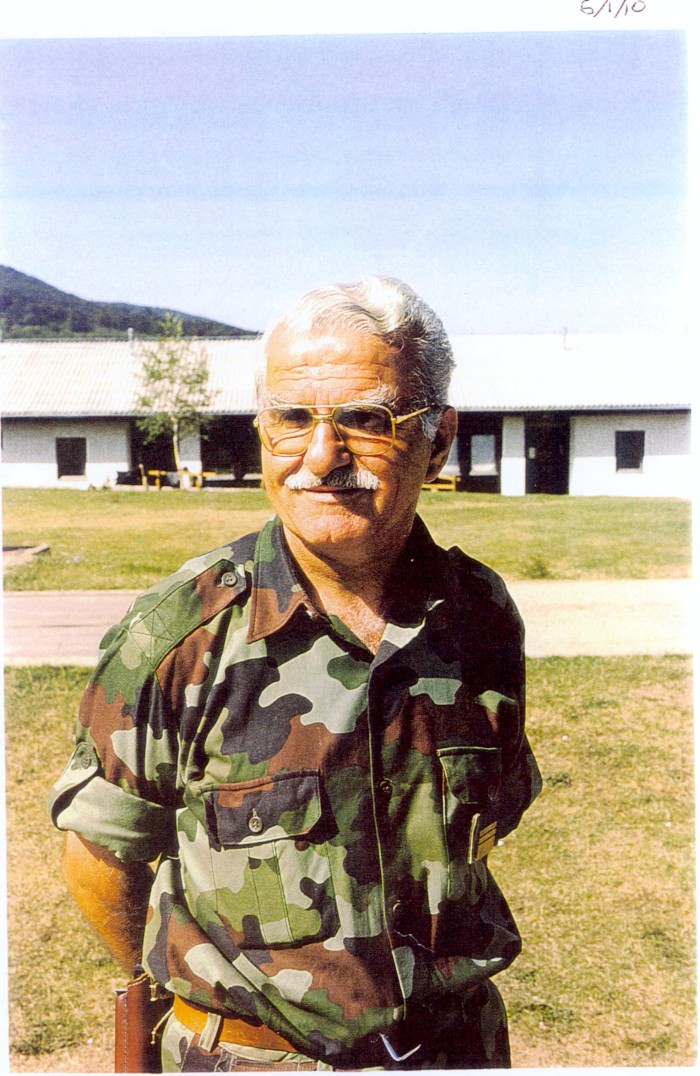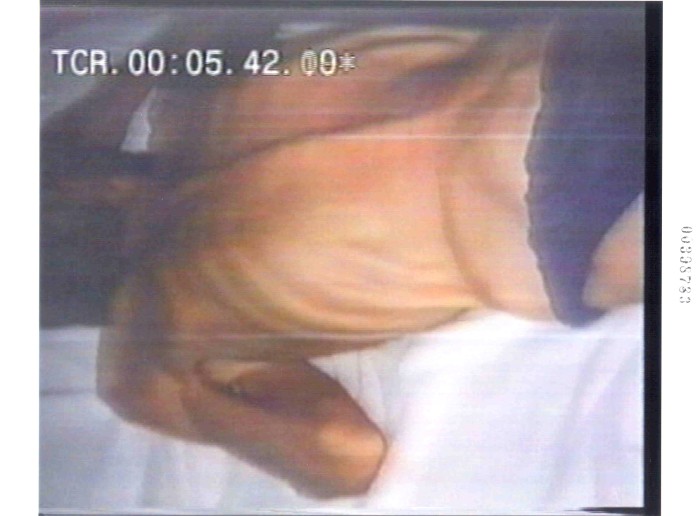United States Air Force to Help Bosnian Muslims
5,000 Bosnian Muslims, including 2,000 children, died of starvation in six besieged enclaves, including Srebrenica and Zepa.
US PREPARATIONS FOR BOSNIA AIRDROP GAINING INTENSITY
Kentucky New Era, p.5A
25 February 1993.
By Laurinda Keys
Sarajevo, Bosnia-Herzegovina (AP) — First, 600,000 leaflets will flutter down on eastern Bosnia, telling residents about a coming American airdrop. Then, tons of food and medicine will fall from the sky.
Our hope is to watch for presents from heaven,” said Fadil Heljic, a ham radio operator in the besieged town of Zepa.
The Defense Department is not disclosing a starting date for its airdrop into eastern Bosnia, but it was expected to start this weekend. It is intended to help about 300,000 cold, hungry Muslims [Bosniaks] in six enclaves besieged by Serb fighters.
About 5,000 people in those areas, including 2,000 children, have died of hunger and cold this winter, according to unconfirmed reports by the Bosnian government. Read the rest of this entry »
American Serbs Deny Genocide in Bosnia
By Anthony Lewis
The Vindicator, p. A10
2 November 1993.
BOSTON — A pathetic byproduct of the genocide in Bosnia has been the attempt by some Americans of Serbian ancestry to deny the reality of the Serbian aggression there.
“What’s happening in Bosnia,” Bob Djurdjevic of Phoenix wrote to The New York Times the other day, “is not genocide’… it is a tragedy largely inflicted on the Muslims by their own government.” Read the rest of this entry »
Serbs Force Bosniak Civilians to Assist in Ethnic Cleansing
Caught Behind the Lines: Bosniaks drafted into Serb army forced to assist in ethnic cleansing
Pittsburgh Post-Gazette, p.A4
13 February 1993.
By Dusan Stojanovic
 ROZAJE, Yugoslavia — Just about anything bad that has happened to Muslims in Bosnia has happened to Sead Sehovic.
ROZAJE, Yugoslavia — Just about anything bad that has happened to Muslims in Bosnia has happened to Sead Sehovic.
He is blind [photo], his face deformed by an explosion. He has been thrown out of his home and his country. As a Bosniak once forced by Serbs to fight his own people, he worries most about his honor.
“Maybe it’s better I cannot see myself in the mirror. I could not stand the reflection of shame and humiliation that I feel inside,” Sehovic said.
After the fighting erupted last year, rebel Serbs took Sehovic from his village near Trebinje in souther Bosnia and forced him to fight against Croats and his fellow Bosniaks. Read the rest of this entry »
UN says Serbs guilty of supporting terrorism
Beaver County Times, p.A4
1 September 1994.
SARAJEVO, Bosnia-Herzegovina (AP) – Bosnian Serb leaders are guilty of “state ordained terrorism” in a campaign purging northern Bosnia of thousands of non-Serbs, a U.N. aid official charged today.
Peter Kessler of the U.N. High Commissioner for Refugees, the main U.N. aid agency, said 3,000 Bosniaks had been driven from their homes in Serb-held areas in August alone. Read the rest of this entry »
Bosnian Muslims pressured to baptize during Genocide in Bosnia
Sun Journal
3 January 1994.
By Barbara Demick
Knight-Rider Newspapers
BIJELJINA, Bosnia-Herzegovina — Two months ago, the police paid an unexpected visit to the home of a Bosniak pediatrician and his wife, a dentist. They had bad news. The city wanted to take over their spacious three-story home for municipal offices.
But the pediatrician also had a surprise for the authorities. He pulled out papers showing that he had legally changed his traditional Bosniak name to a Serbian name. Read the rest of this entry »
Genocide in Bosnia, Chilling Parallels to the Nazis’ attempt to make Europe “Judenrein”
“Never Again” Applies to Bosnia, too
The Jewish Post & News, p.4
12 August 1992.
Never again! That’s the expression Jewish Holocaust survivors and the rest of world Jewry use when referring to the horrors perpetrated by Nazi Germany.
Never again should anyone stand by, shrug off reports about atrocities committed against other human beings, and claim that it’s not worth intervening.
That’s what happened during the Second World War. Informed of the Nazi killing machine at Auschwitz and other death camps, U.S. President Franklin Delano Roosevelt dismissed the suggestion that U.S. planes bomb the camps. FDR claimed he couldn’t spare any planes for such a task.
Now, a similar situation has arisen in Bosnia-Herzegovina. Serbian nationalists are committing brutal attacks on innocent men, women and children throughout that former Yugoslav state, with the assistance of the Serbian government in Belgrade. Read the rest of this entry »
The Western Response to the Bosnian Genocide
West Stands Silent as Bosnian Serbs Wreak Havoc
Milwaukee Journal Sentinel p.10A
4 August 1995.
By George Will
Two years ago, when there were reports that a Bosnian Muslim in a Serbian concentration camp had been forced to bite off his father’s testicles, it was comforting to recall the European tradition of fabricated stories — German soldiers amputating the hands of Belgian nurses in 1914, and so on.
Today, with abundant evidence of rape used as a weapon of war, of Muslims’ eyes gouged out and ears and noses sliced off by Serbian “soldiers” (it is disgusting to give that honorable title to snipers killing Sarajevo children), with testimony about heads on stakes and a woman forced to drink blood from her son’s slit throat, it is reasonable to suspend disbelief concerning all reports about the cowardly mob called the Bosnian Serb “army,” which is a proxy for war criminals in Belgrade. Read the rest of this entry »
Horrific Accounts of Rape of Bosnian Muslim Women and Girls during the Bosnian Genocide
Serbs Gone, But the Horror Remains – Recovery uncertain for all rape victims
By Nancy Nusser
The Tuscaloosa News p.2F / Cox News Service
18 April 1993.
TUZLA, Bosnia-Herzegovina — The pale woman sitting in the health clinic said she hates the son she just delivered and could not bring herself to look at him before nurses took him away.
She is Bosnian, and the baby’s father is the Serb soldier who raped her.
“The child is a Chetnik,” she said, using the derisive word for Serbs. “I hate the child. My brother was in a concentration camp for 10 months and I was raped by Chetniks,” she said. Read the rest of this entry »
Senate Report Provides Details of ‘Ethnic Cleansing’ in Bosnia
Serbs have moved beaten and starved prisoners out of the notorious camps before media visits.
The Milwaukee Journal, p.A6
19 August 1992.
From Journal wire services
Washington, D.C. — The campaign mounted by Serbian militias to drive Muslims [Bosniaks] from large areas of Bosnia-Herzegovina has been so brutal that it probably has caused more deaths than the bombing and shelling of Bosnian cities, according to a Senate staff report. Read the rest of this entry »
It Was Mistake to Negotiate with the Serb Terrorists
West Must Get in or Out
The Vindicator
19 July 1995.
By Anthony Lewis
Two days after the fall of Srebrenica, Gen. Philippe Morillon, French General Staff member, said: “We have to declare war on Gen. Mladic or get out.”
Ratko Mladic is the commander of Bosnian Serb forces, the architect of the assault on Srebrenica and ethnic cleansing that followed [note: this report war published 8 days after the fall of Srebrenica, while the evidence of the large scale massacre surfaced later]
Morillon’s words pitfily summed up one lesson on Bosnia for the Western alliance: To intervene in a conflict and pretend there is no difference between the aggressors and the victims is not only dishonorable but ineffectual.
Read the rest of this entry »
Echoes of the Third Reich in Serb Terror in Srebrenica
Echoes of Third Reich in Ethnic Cleansing
The Milwaukee Journal
17 July 1995.
 Missing from the heart-rending photographs of terrified refugees were the dusty railroad cattle cars and the sullen storm troopers watching with expressionless faces. Nevertheless, some of the roads and villages of [predominantly Bosnian Muslim-inhabited] eastern Bosnia last week looked too much like eastern Europe when it was the Nazis conducting a campaign of ethnic cleansing. Read the rest of this entry »
Missing from the heart-rending photographs of terrified refugees were the dusty railroad cattle cars and the sullen storm troopers watching with expressionless faces. Nevertheless, some of the roads and villages of [predominantly Bosnian Muslim-inhabited] eastern Bosnia last week looked too much like eastern Europe when it was the Nazis conducting a campaign of ethnic cleansing. Read the rest of this entry »
‘Ethnic Cleansing’ Continues in Serb-controlled Bosnia
A Bosniak family was bomb-attacked by Serb men in Banja Luka… A Croat woman was grabbed from the streets in broad daylight and raped by a gang of Serb men… an elderly Croat woman was attacked in the city center by an assailant who cut off her ears and poked out her eyes… Adina, a 19-year-old Bosniak woman was raped on March 8 by four Serb men in military uniforms…
Gainesville Sun, p.8A
26 March 1994.
By John Pomfret
GASNICI, Croatia — Ismet Hrustanovic had an inkling something was going on in his back yard. The engineer’s puppy started yelping. Twigs and leaves crunched under the heavy feet of men in boots.
Next, a fusillate exploded into his two-story house. One bullet passed through his nose, into his eye socket and out near his ear. Another bored into his wife’s ankle. Several more punched holes in the wall near his 10-year-old son. A final blast killed the puppy.
This is how Hrustanovic, a Muslim [Bosniak], spent Monday, Jan. 31 — hunkered down with a bleeding face while his wife writhed in pain in their modest house in the Serb-held Banja Luka region of Bosnia. On Wednesday, they were evacuated from the region by the United Nations and the International Committee of the Red Cross. Read the rest of this entry »
Srebrenica, Zepa: 60 Children, 42 Adults Die from Starvation and Cold
“As for the Bosnian Serb leader, Radovan Karadzic, ‘he will lie, keep lying as he has done all the time, and he will kill more of us in the coming days” – Nedjara Beganovic.
Serb blockade claims lives of more children
The Victoria Advocate, p.4C
13 January 1993.
 SARAJEVO, Bosnia-Herzegovina — Fifty-one children died of starvation and cold overnight in an eastern Bosnian town [Zepa] blockaded by Serbs and isolated for nine months, according to ham radio reports Wednesday. In addition, 34 adults perished Tuesday night in Zepa, 35 miles east of Sarajevo.
SARAJEVO, Bosnia-Herzegovina — Fifty-one children died of starvation and cold overnight in an eastern Bosnian town [Zepa] blockaded by Serbs and isolated for nine months, according to ham radio reports Wednesday. In addition, 34 adults perished Tuesday night in Zepa, 35 miles east of Sarajevo.
In Srebrenica, a town near the Serbia border, 17 people – including nine children – died during the night, according to the reports.
Amateur radio operators have been the only link to the outside for the 28,000 people of Zepa since April. Serb gunmen and mines prevent U.N. convoys from crossing snowy roads to the town, where some people are living in caves. Read the rest of this entry »
Children Born to Rape Victims in the Bosnian Genocide
PHOTO: The maternity hospital at Sveti Duh is packed due to the influx of Bosniak (Bosnian Muslim) refugees in Zagreb, Croatia. As a result, these babies (born to rape victims) are grouped on patients beds before being turned over to CARITAS, a Catholic humanitarian organization. Photographer: Sophie Elbaz.
 PHOTO: A girl bursts into tears while listening to other Bosniak (Bosnian Muslim) women recount their accounts of rape. In Bosnia, a European Community Investigative Mission concluded that 20,000 women and children were victims of systematic rape by the Serbs during the war. Photographer: Sophie Elbaz
PHOTO: A girl bursts into tears while listening to other Bosniak (Bosnian Muslim) women recount their accounts of rape. In Bosnia, a European Community Investigative Mission concluded that 20,000 women and children were victims of systematic rape by the Serbs during the war. Photographer: Sophie Elbaz
 PHOTO: Two Bosniak (Bosnian Muslim) sisters – A., 22, and M., 21 – were violently raped over a period of two months while they were imprisoned in the camp of Modrica, northern Bosnia. They are alone now and are suffering from serious infections due to their rapes. Photographer: Sophie Elbaz
PHOTO: Two Bosniak (Bosnian Muslim) sisters – A., 22, and M., 21 – were violently raped over a period of two months while they were imprisoned in the camp of Modrica, northern Bosnia. They are alone now and are suffering from serious infections due to their rapes. Photographer: Sophie Elbaz
 PHOTO (above, below): Bosniak (Bosnian Muslim) woman, Malima, 20, was a captive in the KLJUC camp for three months and gave birth in Zagreb hospital. “I don’t want to see that ‘thing’. I hate it and those who did it,” she declared to the doctors, who immediately took care of the baby. Ključ is a town and municipality by the same name in western Bosnia and Herzegovina. Photographer: Sophie Elbaz
PHOTO (above, below): Bosniak (Bosnian Muslim) woman, Malima, 20, was a captive in the KLJUC camp for three months and gave birth in Zagreb hospital. “I don’t want to see that ‘thing’. I hate it and those who did it,” she declared to the doctors, who immediately took care of the baby. Ključ is a town and municipality by the same name in western Bosnia and Herzegovina. Photographer: Sophie Elbaz
The Rapes in Bosnia: A Muslim Schoolgirl’s Account
The Washington Post
27 December 1992.
By: Peter Maass Read the rest of this entry »
Another View of the Concentration Camps in the Bosnian Genocide
The following images of Serb-run concentration camps near Prijedor in north-west Bosnia were taken from the archive of the International Criminal Tribunal for the Former Yugoslavia (ICTY) at the Hague.

Aerial view of the notorious Serb-run Omarska concentration camp in north-west Bosnia, near Prijedor, in August of 1992. Thousands of Bosniak (Bosnian Muslim) civilians were interned, tortured, raped, and killed in this camp.

Aerial view of the notorious Serb-run Omarska concentration camp in north-west Bosnia, near Prijedor, in August of 1992. Thousands of Bosniak (Bosnian Muslim) civilians were interned, tortured, raped, and killed in this camp.

The Sign reads CONCENTRATION CAMP. PROHIBITED ENTRY. Photo: Entrance to the Manjaca concentration camp near Prijedor, north-west Bosnia, where Serbs interned, tortured, raped, and killed thousands of Bosniaks (Bosnian Muslims).
Here is a better quality of this image from the same source (images may be lighter or darker depending on how they were scanned and depending on the source they were scanned from, e.g. printed newspaper):
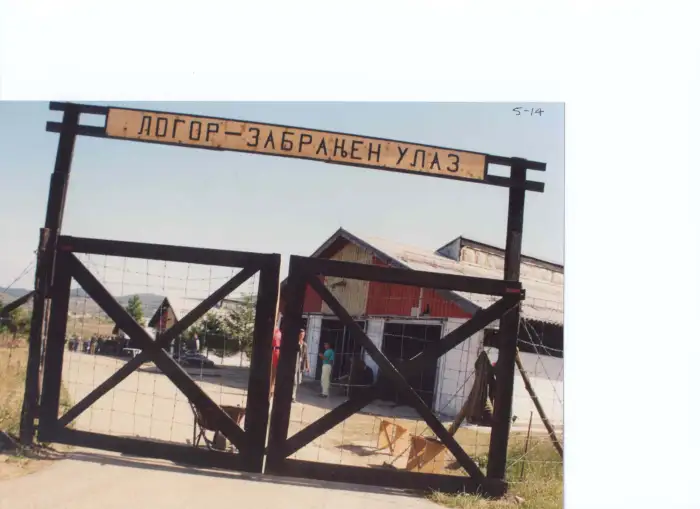
The Sign reads CONCENTRATION CAMP. PROHIBITED ENTRY. Photo: Entrance to the Manjaca concentration camp near Prijedor, north-west Bosnia, where Serbs interned, tortured, raped, and killed thousands of Bosniaks (Bosnian Muslims).

Bosniak (Bosnian Muslim) civilians in the notorious Serb-run Manjaca concentration camp in north-west Bosnia, near Prijedor, in August of 1992.

Bosniak (Bosnian Muslim) civilians the notorious Serb-run Manjaca concentration camp in north-west Bosnia, near Prijedor, in August of 1992.

Bosniak (Bosnian Muslim) civilians in the notorious Serb-run Manjaca concentration camp in north-west Bosnia, near Prijedor, in August of 1992.
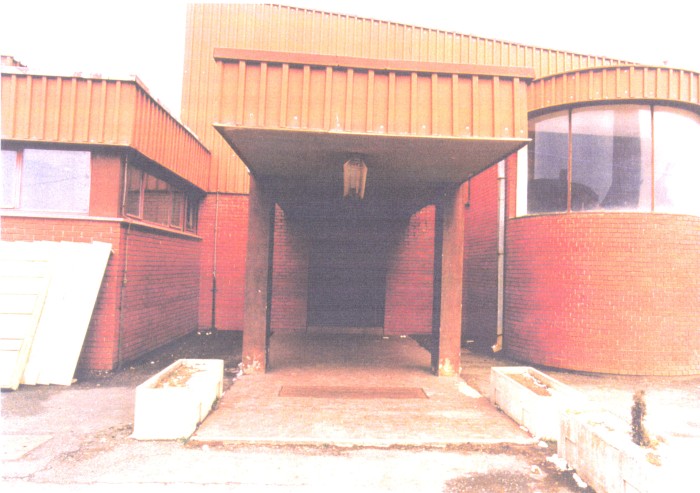
One of entrances to notorious Serb-run Omarska concentration camp near Prijedor, north-west Bosnia. Thousands of Bosniak (Bosnian Muslims) civilians were interned, tortured, raped and killed in this camp.

Inside view, hall, of the Omarska concentration camp near Prijedor, north-west Bosnia. Thousands of Bosniak (Bosnian Muslims) civilians were interned, tortured, raped and killed in this camp.

Outside view from one of the rooms used by Serbian guards of the Omarska concentration camp where Serbs interned, tortured, raped and killed thousands of Bosniaks (Bosnian Muslims) during the Bosnian Genocide.

Beds in the Omarska concentration camp near Prijedor, north-west Bosnia. Beds were introduced as a media propaganda after the Serb leadership allowed British TV crews to visit Omarska. Prisoners slept on the floor. Thousands of Bosniak (Bosnian Muslims) civilians were interned, tortured, raped and killed in this camp.

The building of the Serb-run Keraterm concentration camp near Prijedor, north-west Bosnia. Thousands of Bosniak (Bosnian Muslims) civilians were interned, tortured, raped and killed in this camp.

Badly beaten and emaciated Bosniak (Bosnian Muslim) man from the village of Hrnici, later died, in the Trnopolje concentration camp (Bosnian Genocide)

Emaciated Bosniak (Bosnian Muslim) men in the Trnopolje concentration camp near Prijedor, north-west Bosnia, during the Bosnian Genocide.

Emaciated Bosniak (Bosnian Muslim) man in the Trnopolje concentration camp near Prijedor, north-west Bosnia, during the Bosnian Genocide.

Tortured, beaten, and emaciated Bosniak (Bosnian Muslim) men in the Trnopolje concentration camp near Prijedor, north-west Bosnia, during the Bosnian Genocide.

BBC TV crew speaks with emaciated Bosniak (Bosnian Muslim) man in the Trnopolje concentration camp. Serb authorities allowed TV crew to enter the camp after international pressure mounted. Badly emaciated prisoners were removed from the camp, but Dr. Idriz Merdzanic managed to smuggle some photos of brutal beatings and abuse in the camp, which we will show beginning from the next photo.

Emaciated and visibly weak Bosniak (Bosnian Muslim) man in the Trnopolje concentration camp in August of 1992 at the start of the Bosnian Genocide.

Covert images submitted to the British TV crew by Dr. Idriz Merdzanic from the Trnopolje concentration camp in August of 1992 during the Bosnian Genocide.

Covert images submitted to the British TV crew by Dr. Idriz Merdzanic from the Trnopolje concentration camp in August of 1992 during the Bosnian Genocide.
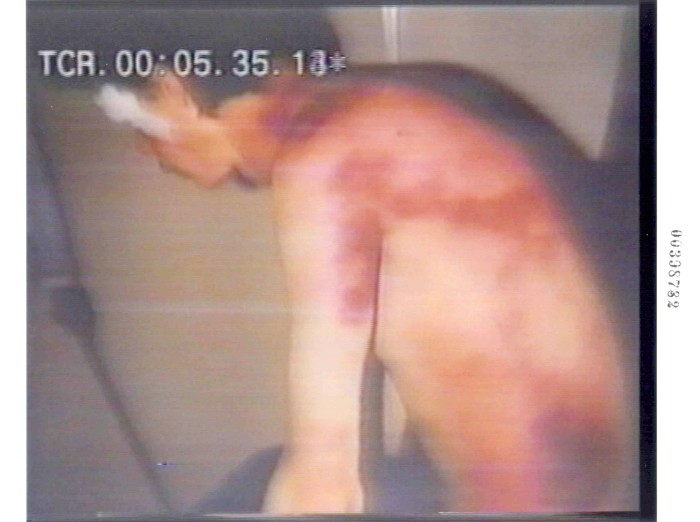
Covert images submitted to the British TV crew by Dr. Idriz Merdzanic from the Trnopolje concentration camp in August of 1992 during the Bosnian Genocide.
Serbs Beat up Elderly Civilians during Srebrenica genocide
A 11 July 1995 file photo shows an elderly Bosniak (Bosnian Muslim) woman and her husband getting treatment for injuries inflicted on them by Serb military forces as they fled Srebrenica as it was overrun by Bosnian Serb forces. The man on the right died shortly after the picture was taken. During the Srebrenica genocide, Serb forces rounded up and killed more than 8,000 Bosniak men and boys, and expelled 25,000 women after abusing many of them. General Ratko Mladic ordered his troops to rape Muslim women and girls. Source: (Getty Images)
Serbs Intended & Planned the Destruction of Bosniak People
The aim of the war in Bosnia-Herzegovina was to destroy the Bosnian Muslims
Author: Florence Hartmann
Interviewed by Dani (Sarajevo)
Translated by the Bosnian Institute, UK on 16 August, 2007
Florence Hartmann covered the former Yugoslavia for Le Monde, later became the most prominent spokesperson for the Hague Tribunal, and is the author of a study of Slobodan Miloševic Read the rest of this entry »
Report: Serbs Raped, Deliberately Killed 700 Bosniaks During Attack on Gorazde
New Straits Times
12 June 1994.
GENEVA, Sat. — A United Nations investigator yesterday accused Serbs of launching a campaign of rape and murder when they attacked the Bosniak-held enclave of Gorazde and surrounding villages earlier this year. Read the rest of this entry »
12-year-old Bosniak Girl Describes Rape by Serb Soldiers
Daily News, p.2
12 December 1992.
ZAGREB, Croatia — The Serbian fighters who have seized large parts of Bosnia-Herzegovina are being accused of systematic rape against captured Bosniak [Bosnian Muslim] women and girls. Read the rest of this entry »
Why did Bosnian Genocide Survivor Hung Herself?

Photo: Bosniak (Bosnian Muslim) woman Ferida Osmanovic hanging from a tree. Photo by Darko Bandic. U.S. Dept of State said another 14-year-old Bosniak child hung herself with her scarf in Potocari after she and her 12-year old cousin were raped by Serb soldiers.
The Last Rational Act in Bosnia
By Sue Reisinger
Miami Herald, p.A6
26 July 1995.
The Miami Herald’s wire services late last week sent us the picture of a woman about 20 who had hanged herself in a grove of trees in Bosnia.
Some editors found the picture in poor taste, and another said, “Well, we don’t really know why the woman hanged herself, do we?” Besides, several concluded, it was an irrational act.
Irrational?
Let’s look at what we do know: The woman was one of tens of thousands of terrorized Muslims [Bosniaks] who had fled to an emergency camp after the Serbs overran their United Nations-guarded “safe haven” [Srebrenica].
Read the rest of this entry »
Photojournalism: Bijeljina Massacre, First Day of Bosnian War

Bosnian Genocide, 1992: On 31 March 1992, Serbian paramilitary group, led by Zeljko Raznjatovic (ARKAN), slaughtered hundreds of Bosniak (Bosnian Muslim) civilians - women, children, and elderly men - in the town of Bijeljina in northeastern Bosnia, near the border with Serbia. Photographer: Ron Haviv

Bosnian Genocide, 1992: A Serbian paramilitary soldier from Arkan's Tigers shoots Bosniak (Bosnian Muslim) civilians in the street of Bijeljina on 31 March 1992, the first day of the Bosnian war. Photographer: Ron Haviv

Bosnian Genocide, 1992: Serbian paramilitaries kick and kill Bosniak (Bosnian Muslim) civilians on the streets of Bijeljina on 31 March 1992, the first day of the Bosnian war. Serbian troops slaughtered hundreds of unarmed Bosniak (Bosnian Muslim) civilians - men, women, children and elderly - in during the attack on this norteastern Bosnian city. Photographer: Ron Haviv

Bosnian Genocide, 1992: On 31 March 1992, Serbian paramilitary group, led by Zeljko Raznjatovic (ARKAN), slaughtered hundreds of Bosniak (Bosnian Muslim) civilians - women, children, and elderly men - in the town of Bijeljina in northeastern Bosnia, near the border with Serbia. Photographer: Ron Haviv

Bosnian Genocide, 1992: Frightened Bosniak (Bosnian Muslim) civilians in the town of Biljeljina. On 31 March 1992, Serbian paramilitary group, led by Zeljko Raznjatovic (ARKAN), slaughtered hundreds of Bosniak (Bosnian Muslim) civilians - women, children, and elderly men - in the town of Bijeljina in northeastern Bosnia, near the border with Serbia. Photographer: Ron Haviv

Bosnian Genocide, 1992: Serbian paramilitaries during the attack on Bijeljina in northeastern Bosnia in the first day of war on 31 March 1992. They slaughtered hundreds of unarmed Bosniak (Bosnian Muslim) civilians - men, women, children and elderly. Photographer: Ron Haviv

Bosnian Genocide, 1992: Serbian paramilitaries known as Arkan's Tigers desecrate Mosque in the northeastern Bosnian town of Bijeljina on 31 March 1993, the first day of the Bosnian war. Serbian troops slaughtered hundreds of Bosniak men, women, children and elderly during the attack on Bijeljina. Photographer: Ron Haviv
Serbs Raped Bosniak Woman in Front of Her Children, Then They Urinated in Children's Mouth

Bosniak woman Aziza (not her real name) is a 29-year-old mother of 3 who was raped in front of her children by Serbian troops at Brcko. After repeatedly raping her in front of her children, Serbs then urinated in the children's mouths. During the entire month of December of 1992, the rapes continued and she was 2-months pregnant (at the time this picture was taken) and wants an abortion. Bosnian Muslim women were systematically raped during the Bosnian Genocide (1992-95). Photographer: Sophie Elbaz

Bosniak woman Aziza (not her real name) is a 29-year-old mother of 3 who was raped in front of her children by Serbian troops at Brcko. After repeatedly raping her in front of her children, Serbs then urinated in the children's mouths. During the entire month of December of 1992, the rapes continued and she was 2-months pregnant (at the time this picture was taken) and wants an abortion. Bosnian Muslim women were systematically raped during the Bosnian Genocide (1992-95). Photographer: Sophie Elbaz
Photojournalism: Manjaca Concentration Camp in Bosnia

Bosnian Genocide, August 1992. The entrance to the Manjaca concentration camp reads in cyrillic letters CONCENTRATION CAMP - PROHIBITED ENTRY. Thousands of civilians, mostly Bosniaks (Bosnian Muslims) were tortured and killed there. Photographer: Antoine Gyori

Bosnian Genocide, August 1992. Sign (visible from Center to Right) written in cyrillic letters reads MINES. Manjaca concentration camp near Prijedor, north-west Bosnia. The camp was surrounded by mines to prevent escape of prisoners. Thousands of civilians, mostly Bosniaks (Bosnian Muslims) were tortured and killed there. Photographer: Patrick Robert

Bosnian Genocide, August 1992. Sign (visible from Center to Left) written in cyrillic letters reads MINES. Manjaca concentration camp near Prijedor, north-west Bosnia. The camp was surrounded by mines to prevent escape of prisoners. Thousands of civilians, mostly Bosniaks (Bosnian Muslims) were tortured and killed there. Photographer: Patrick Robert

Bosnian Genocide, August 1992. Emaciated prisoner in the Manjaca concentration camp near Prijedor, north-west Bosnia. Thousands of civilians, mostly Bosniaks (Bosnian Muslims) were tortured and killed there. Photographer: Isabel Ellsen

Bosnian Genocide, August 1992. Emaciated prisoners in the Manjaca concentration camp near Prijedor, north-west Bosnia. Thousands of civilians, mostly Bosniaks (Bosnian Muslims) were tortured and killed there. Photographer: Antoine Gyori

Bosnian Genocide, August 1992. Emaciated prisoners in the Manjaca concentration camp near Prijedor, north-west Bosnia. The camp was controlled by Lieutenant Colonel Bozidar Popovic.Thousands of civilians, mostly Bosniaks (Bosnian Muslims) were tortured and killed there. Photographer: Antoine Gyori

Bosnian Genocide, August 1992. Emaciated prisoners in the Manjaca concentration camp near Prijedor, north-west Bosnia. Thousands of civilians, mostly Bosniaks (Bosnian Muslims) were tortured and killed there. Photographer: Patrick Robert

Bosnian Genocide, August 1992. Emaciated and tortured prisoners in the Manjaca concentration camp near Prijedor, north-west Bosnia. Thousands of civilians, mostly Bosniaks (Bosnian Muslims) were tortured and killed there. Photographer: Patrick Robert

Bosnian Genocide, 1992. Manjaca concentration camp near Prijedor, north-west Bosnia. Photographer: Patrick Robert

Bosnian Genocide, August 1992. Manjaca concentration camp near Prijedor, north-west Bosnia. Thousands of civilians, mostly Bosniaks (Bosnian Muslims) were tortured and killed there. Photographer: Pascal Le Segretain

Bosnian Genocide, August 1992. Manjaca concentration camp near Prijedor, north-west Bosnia. Thousands of civilians, mostly Bosniaks (Bosnian Muslims) were tortured and killed there. Photographer: Ron Haviv

Bosnian Genocide, August 1992. Manjaca concentration camp near Prijedor, north-west Bosnia. Thousands of civilians, mostly Bosniaks (Bosnian Muslims) were tortured and killed there. Photographer: Isabel Ellsen

Bosnian Genocide, August 1992. Manjaca concentration camp near Prijedor, north-west Bosnia. Thousands of civilians, mostly Bosniaks (Bosnian Muslims) were tortured and killed there. Photographer: Isabel Ellsen

Bosnian Genocide, August 1992. Manjaca concentration camp near Prijedor, north-west Bosnia. Thousands of civilians, mostly Bosniaks (Bosnian Muslims) were tortured and killed there. Photographer: Patrick Robert

Bosnian Genocide, August 1992. Manjaca concentration camp near Prijedor, north-west Bosnia. Thousands of civilians, mostly Bosniaks (Bosnian Muslims) were tortured and killed there. Photographer: Antoine Gyori

Bosnian Genocide, August 1992. Manjaca concentration camp near Prijedor, north-west Bosnia. Thousands of civilians, mostly Bosniaks (Bosnian Muslims) were tortured and killed there. Photographer: Isabel Ellsenq

Bosnian Genocide, August 1992. Manjaca concentration camp near Prijedor, north-west Bosnia. Thousands of civilians, mostly Bosniaks (Bosnian Muslims) were tortured and killed there. Photographer: Isabel Ellsen

Bosnian Genocide, August 1992. Manjaca concentration camp near Prijedor, north-west Bosnia. Thousands of civilians, mostly Bosniaks (Bosnian Muslims) were tortured and killed there. Photographer: Isabel Ellsen

Bosnian Genocide, August 1992. Manjaca concentration camp near Prijedor, north-west Bosnia. Thousands of civilians, mostly Bosniaks (Bosnian Muslims) were tortured and killed there. Photographer: Patrick Robert
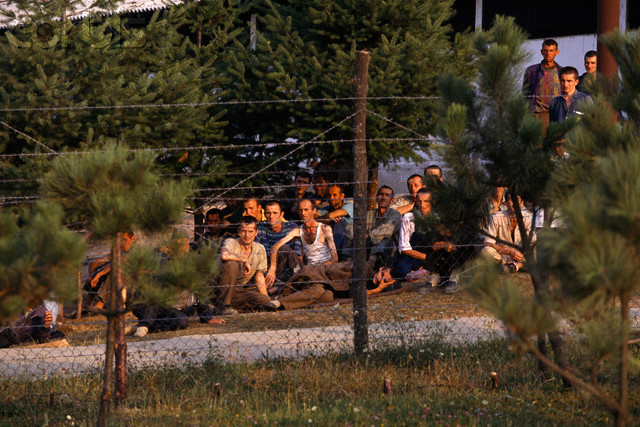
Bosnian Genocide, August 1992. Manjaca concentration camp near Prijedor, north-west Bosnia. Thousands of civilians, mostly Bosniaks (Bosnian Muslims) were tortured and killed there. Photographer: Patrick Robert

Bosnian Genocide, August 1992. Manjaca concentration camp near Prijedor, north-west Bosnia. Thousands of civilians, mostly Bosniaks (Bosnian Muslims) were tortured and killed there. Photographer: Isabel Ellsen

Bosnian Genocide, August 1992. Manjaca concentration camp near Prijedor, north-west Bosnia. Thousands of civilians, mostly Bosniaks (Bosnian Muslims) were tortured and killed there. Photographer: Patrick Robert

Bosnian Genocide, August 1992. Manjaca concentration camp near Prijedor, north-west Bosnia. Thousands of civilians, mostly Bosniaks (Bosnian Muslims) were tortured and killed there. Photographer: Patrick Robert

Bosnian Genocide, August 1992. Manjaca concentration camp near Prijedor, north-west Bosnia. Thousands of civilians, mostly Bosniaks (Bosnian Muslims) were tortured and killed there. Photographer: Patrick Robert

Bosnian Genocide, August 1992. Manjaca concentration camp near Prijedor, north-west Bosnia. Thousands of civilians, mostly Bosniaks (Bosnian Muslims) were tortured and killed there. Photographer: Patrick Robert

Bosnian Genocide, August 1992. Emaciated prisoners in the Manjaca concentration camp near Prijedor, north-west Bosnia. The camp was controlled by Lieutenant Colonel Bozidar Popovic.Thousands of civilians, mostly Bosniaks (Bosnian Muslims) were tortured and killed there. Photographer: Antoine Gyori

Bosnian Genocide, August 1992. Manjaca concentration camp near Prijedor, north-west Bosnia. Thousands of civilians, mostly Bosniaks (Bosnian Muslims) were tortured and killed there. Photographer: Isabel Ellsen

Bosnian Genocide, August 1992. Manjaca concentration camp near Prijedor, north-west Bosnia. Thousands of civilians, mostly Bosniaks (Bosnian Muslims) were tortured and killed there. Photographer: Isabel Ellsen

Bosnian Genocide, August 1992. Manjaca concentration camp near Prijedor, north-west Bosnia. Thousands of civilians, mostly Bosniaks (Bosnian Muslims) were tortured and killed there. Photographer: Patrick Robert

Bosnian Genocide, August 1992. Manjaca concentration camp near Prijedor, north-west Bosnia. Thousands of civilians, mostly Bosniaks (Bosnian Muslims) were tortured and killed there. Photographer: Pascal Le Segretain

Bosnian Genocide, August 1992. Prisoner in the Manjaca concentration camp near Prijedor, north-west Bosnia. Thousands of civilians, mostly Bosniaks (Bosnian Muslims) were tortured and killed there. Photographer: Ron Haviv

Bosnian Genocide, August 1992. Manjaca concentration camp near Prijedor, north-west Bosnia. Thousands of civilians, mostly Bosniaks (Bosnian Muslims) were tortured and killed there.Photographer: Patrick Robert

Bosnian Genocide, August 1992. Manjaca concentration camp near Prijedor, north-west Bosnia. Thousands of civilians, mostly Bosniaks (Bosnian Muslims) were tortured and killed there. Photographer: Patrick Robert

Bosnian Genocide, August 1992. Manjaca concentration camp near Prijedor, north-west Bosnia. Thousands of civilians, mostly Bosniaks (Bosnian Muslims) were tortured and killed there. Photographer: Isabel Ellsen

Bosnian Genocide, August 1992. Prisoner in the Manjaca concentration camp near Prijedor, north-west Bosnia. Thousands of civilians, mostly Bosniaks (Bosnian Muslims) were tortured and killed there. Photographer: Ron Haviv

Bosnian Genocide, August 1992. Manjaca concentration camp near Prijedor, north-west Bosnia. Thousands of civilians, mostly Bosniaks (Bosnian Muslims) were tortured and killed there. Photographer: Isabel Ellsen
Photojournalism: Trnopolje concentration camp in Bosnia

Bosnian Genocide, 1992: Emaciated prisoner in the Serb-run Trnopolje concentration camp near Prijedor, Bosnia, in August of 1992. Thousands of civilians, mostly Bosniaks (Bosnian Muslms), were tortured and killed there. Photographer: Pascal Le Segretain

Bosnian Genocide, 1992: Bosniak (Bosnian Muslim) woman and children upon arrival to the Serb-run Trnopolje concentration camp in August 1992. Thousands of non-Serbs civilians were tortured, raped and killed there in 1992. Photographer: Patrick Robert

Bosnian Genocide, 1992: Emaciated Bosniak (Bosnian Muslim) man, posing for cameras, during a staged lunch at the Serb-run Trnopolje concentration camp near Prijedor, Bosnia, in August 1992. Thousands of prisoners, mostly Bosniaks (Bosnian Muslims), were tortured and killed there in 1992. Photographer: Patrick Robert

Bosnian Genocide, 1992: Woman and a child in the Serb-run Trnopolje concentration camp near Prijedor, Bosnia, in August of 1992. Women and girls were brutally raped by Serb soldier at Trnopolje. Thousands of civilians, mostly Bosniaks (Bosnian Muslms), were tortured and killed there. Photographer: Patrick Robert

Bosnian Genocide, 1992: A Bosniak (Bosnian Muslim) civilian imprisoned by Serbian forces in the Serb-run Trnopolje concentration camp near Prijedor in 1992. Thousands of civilians, mostly Bosniaks, were tortured and killed there in 1992. Photographer: Ron Haviv

Bosnian Genocide, 1992: Non-Serb civilians imprisoned in the Serb-run Trnopolje concentration camp near Prijedor in 1992. Thousands of prisoners, mostly Bosniaks, were tortured and killed there in 1992. Photographer: Ron Haviv
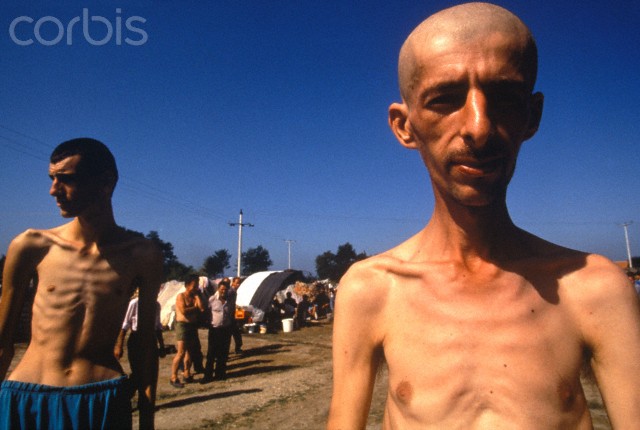
Bosnian Genocide, 1992: Non-Serb civilians imprisoned in the Serb-run Trnopolje concentration camp near Prijedor in 1992. Thousands of prisoners, mostly Bosniaks, were tortured and killed there in 1992. Photographer: Ron Haviv

Bosnian Genocide, 1992: Emaciated non-Serb civilians imprisoned in the Serb-run Trnopolje concentration camp near Prijedor in 1992. Thousands of prisoners, mostly Bosniaks, were tortured and killed there in 1992. Photographer: Pascal Le Segretain

Bosnian Genocide, 1992: Emaciated non-Serb civilians imprisoned in the Serb-run Trnopolje concentration camp near Prijedor in 1992. Thousands of prisoners, mostly Bosniaks (Bosnian Muslims), were tortured and killed there in 1992. Photographer: Patrick Robert
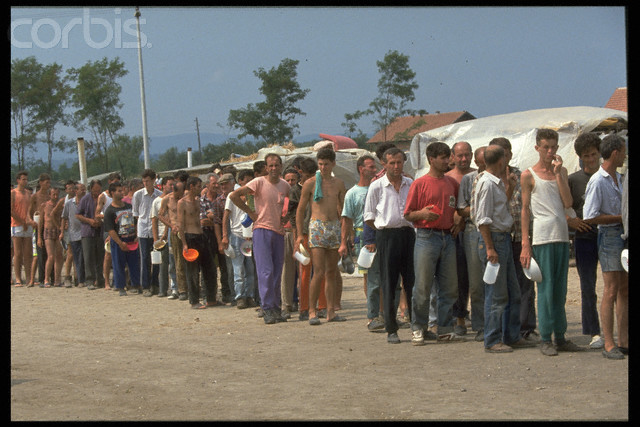
Bosnian Genocide, 1992: Emaciated non-Serb civilians imprisoned in the Serb-run Trnopolje concentration camp near Prijedor in 1992. Thousands of prisoners, mostly Bosniaks (Bosnian Muslims), were tortured and killed there in 1992. Photographer: Patrick Robert

Bosnian Genocide, 1992: Emaciated non-Serb civilians during a staged lunch, posing for TV cameras, at the Serb-run Trnopolje concentration camp near Prijedor in 1992. Thousands of prisoners, mostly Bosniaks (Bosnian Muslims), were tortured and killed there in 1992. Photographer: Patrick Robert

Bosnian Genocide, 1992: Emaciated non-Serb civilians during a staged lunch, posing for TV cameras, at the Serb-run Trnopolje concentration camp near Prijedor in 1992. Thousands of prisoners, mostly Bosniaks (Bosnian Muslims), were tortured and killed there in 1992. Photographer: Patrick Robert

Bosnian Genocide, 1992: Emaciated non-Serb civilians during a staged lunch, posing for TV cameras, at the Serb-run Trnopolje concentration camp near Prijedor in 1992. Thousands of prisoners, mostly Bosniaks (Bosnian Muslims), were tortured and killed there in 1992. Photographer: Patrick Robert

Bosnian Genocide, 1992: Emaciated non-Serb civilians, posing for cameras, line up for food or water during a staged lunch at the Serb-run Trnopolje concentration camp near Prijedor, Bosnia, in August 1992. Thousands of prisoners, mostly Bosniaks (Bosnian Muslims), were tortured and killed there in 1992. Photographer: Antoine Gyori

Bosnian Genocide, 1992: Emaciated non-Serb civilians, posing for cameras, line up for food or water during a staged lunch at the Serb-run Trnopolje concentration camp near Prijedor, Bosnia, in August 1992. Thousands of prisoners, mostly Bosniaks (Bosnian Muslims), were tortured and killed there in 1992. Photographer: Antoine Gyori
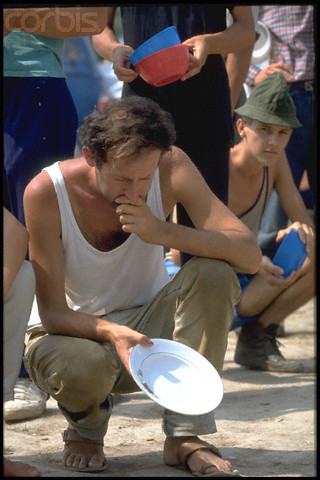
Bosnian Genocide, 1992: Emaciated Bosniak (Bosnian Muslim) man, posing for cameras, during a staged lunch at the Serb-run Trnopolje concentration camp near Prijedor, Bosnia, in August 1992. Thousands of prisoners, mostly Bosniaks (Bosnian Muslims), were tortured and killed there in 1992. Photographer: Patrick Robert
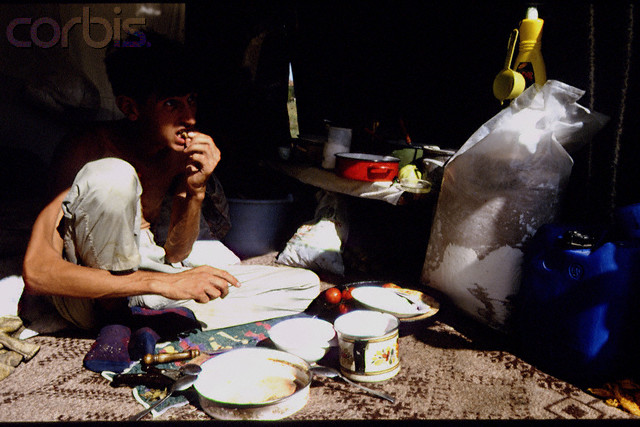
Bosnian Genocide, 1992: Emaciated Bosniak (Bosnian Muslim) man, posing for cameras, during a staged lunch at the Serb-run Trnopolje concentration camp near Prijedor, Bosnia, in August 1992. Thousands of prisoners, mostly Bosniaks (Bosnian Muslims), were tortured and killed there in 1992. Photographer: Pascal Le Segretain
Photojournalism: Omarska concentration camp in Bosnia

Bosnian Genocide, 1992: Bosniak (Bosnian Muslim) and Croat (Bosnian Catholic) survivors of the Serb-run Omarska concentration camp in western Bosnia near Prijedor on August 6, 2006, c ommemorate the 14th anniversary of the reveleation of death camps by British journalists in August 1992. Photographer: Ranko Cukovic

Bosnian Genocide, 1992: TV pictures of the Serb-run Omarska concentration camp in western Bosnia near Prijedor, August 1992. Thousands of civilians, mostly Bosniaks (Bosnian Muslims), died there.
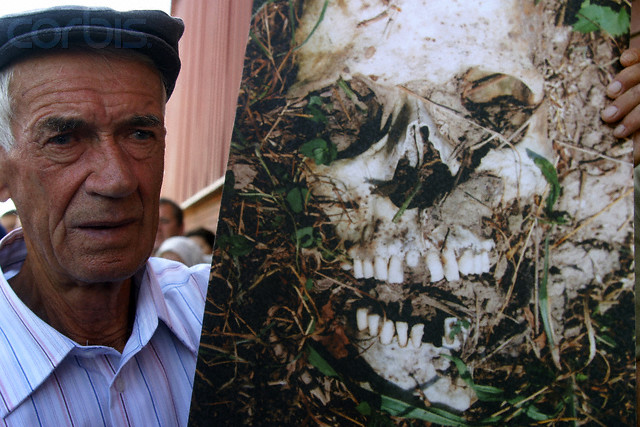
An elderly Bosnian Muslim man holds up a poster at a rally in former Omarska concentration camp near Prijedor, Bosnia, on August 6, 2006, commemorating the 14th anniversary of the revelation of death camps by British journalists in August 1992. Photographer: Ranko Cukovic

Bosnian Genocide, 1992: TV Pictures of the Serb-run Omarska concentration camp taken on 7 August 1992.

Bosnian Genocide, 1992: TV Pictures of the Serb-run Omarska concentration camp taken on 7 August 1992.

Bosnian Genocide, 1992: Bosnian Muslim civilians at the Serb-run Omarska concentration camp pose for cameras. Photographer: Antoine Gyori

Bosnian Genocide, 1992: TV Pictures of the Serb-run Omarska concentration camp near Prijedor, Bosnia. Thousands of civilians, mostly Bosniaks, died there in 1992.

Bosnian Genocide, 1992: Relative of the Omarska concentration camp victims near the Western Bosnian town of Prijedor in Bosnia-Herzegovina holds photos of excavated bodies of her relatives on 06 August, 2006.

A Bosnian Muslim woman holds a poster during a visit to the former Serb-run Omarska concentration camp in western part of Bosnia, near Prijedor, on August 6, 2006, to commemorate the 14th anniversary of the revelation of death camps by British journalists in August 1992. Thousands of non-Serbs, mostly Bosniaks (Bosnian Muslims), were tortured and murdered in three notorious concentration camps in western Bosnia. Several of high-profile Serb commanders have been sentenced by the U.N. war crimes tribunal in The Hague for the atrocities committed there.

Ed Vulliamy addresses Bosniak (Bosnian Muslim) and Croat (Bosnian Catholic) survivors of the Serb-run Omarska concentration camp near Prijedor in western Bosnia, August 6, 2006, during the 14th anniversary of reveleation of death camps by British journalists. Photographer: Ranko Cukovic

Bosnian Genocide, 1992: 21-year-old Edna Dautovic was one of many Bosniak (Bosnian Muslim) women who were tortured, brutally raped, and then killed by the Serbs in the Omarska concentration camp near Prijedor. Pre-war photo of Edna Dautovic courtesy of the International Criminal Tribunal for the Former Yugoslavia (ICTY).
Brcko Genocide: 3,000 Bosniak Civilians Mutilated, Blood Drained, Burned in Furnace

Close-up of the drain at the Brcko Luka camp facility. Witnesses detailed how Serbs executed victims, slaughtering their throats, and forcing their heads on the grate covering the drain. (Bosnian Genocide, 1992)
U.S. Department of State
November 6, 1992.
About 3,000 men, women, and children were killed during May and June at the Luka-Brcko camp, which held approximately 1,000 civilian internees at any one time. Some 95% were ethnic Bosniaks, and the remainder were Croatians. Approximately 95% were men. Until May, the bodies were dumped into the Sava River. Thereafter they were transported to and burned in both the old and new “kafilerija” factories located in the vicinity of Brcko.
All internees in the camp came from within a 14 kilometer radius of Brcko. The first hangar was occupied by Bosniaks from Brezovo Polje. The Serbian police appeared to have administrative control of the camp.
Upon arrival, all internees were questioned by one of three inspectors who decided their fate. For example, if a person was a member of the SDA [Bosniak Party for Democratic Action] or HDZ [Croatian Party for Democratic Action] political parties, he was executed at the camp. Other questions included whether the person had foreign currency, gold, or weapons, or if the neighbor might have any of these items. Without a signature from either the police chief at the camp, or one of the military officers, a person could not be released. Approximately 1,000 people were released from the camp when Serbs vouched with their lives – and signed documents to that effect – that the internees would not leave Brcko, discuss politics, or own weapons. These people were all released within a 48-hour period; thereafter releases were not authorized. One example was an individual who had his ears cut off with a knife by a Specijalci soldier. As he grabbed for his ears in pain, a young women cut off his genitalia with an instrument called a “spoon.” As he fell forward and lay on the ground, he was shot in the head by a guard. In other instances, ears and noses were cut off and eyes gouged out. Knives were used to cut into the skin of internees all the way to the bone; some fingers were cut off entirely. All was done in front of other internees.
Beatings with clubs were common. A Specijalci soldier used a wooden club with metal protruding from it to kill several people. He forced internees to lick the blood from the metal studs. Another shot an individual in the back several times after he had carried a dead body behind the third hangar. In June, some 50-60 men had their genitalia removed.
Approximately 10-15 Chetniks [definition: In World War II – Serbian nazi collaborators; In Bosnian war – Serbian paramilitary thugs], Yugoslav Federal Specijalci, and Serbian police were involved during the daily occurrences, but some participated on a more regular basis. Some were drunk. Internees were told to sing. Those who did not sing loud enough were shot point blank. After they had started singing, the men would come in and randomly start shooting. About 50 men, women, and children were killed in one case, allegedly in retaliation for the death of 12 Chetniks who had been killed on the front. This type of shooting occurred on a daily basis with anywhere form 15 to 50 victims.
There was also a torture room at Luka-Brcko camp. Those tortured were either killed immediately after being tortured or were left to bleed and, if they did not die in 2 to 4 days on their own, shot to death. They were left lying in their own blood in the living areas and other internees were not allowed to help in any way. People were beaten with clubs to the point that the bones in their faces caved in, and they died.
The internees were then “volunteered” by camp personnel to carry the dead bodies behind their living areas or to the camp garbage dump. During the movement of the bodies, additional internees were killed when a camp official took shots at them.
Another frequent occurrence was the shooting of internees with three bullets in the back of the head of each victim. This was done at a drain, and the blood was allowed to go down the drain that emptied into the Sava River. Internees carried victims, some still alive, and had to dump their bodies at the camp garbage dump. Internees were sent on a detail to clean the blood from the floor and dump dead bodies outside of a Serbian building in Brcko. A female internee was sexually assaulted by a soldier while her husband and other internees watched. One Chetnik sexually assaulted several women, some as young as 12, in front of internees as Specijalci soldiers held the women to the ground. The same man killed 80-100 people at the camp. Another Chetnik sexually assaulted women and killed internees, in some cases using an ax to the head.

Serbs burned dead bodies of Bosniak (Bosnian Muslim) civilians at the old kafilerija factory in Brcko during the 1992 Bosnian Genocide. Some 3,000 victims perished in the systematic killings that occurred in May and June 1992.
The dead bodies of internees from the Brcko camp were burned at the old “kafilerija” factory. The trucks carrying bodies drove into a building that had three industrial-sized cooking vats with furnaces used ordinarily to make animal feed. The bodies were dumped inside the building with the three furnaces, then Chetniks dumped the dead bodies into the furnaces. Before the bodies were dumped, jewelry was removed from them and, in order to remove rings, fingers were cut off. Gold and silver teeth were removed from the bodies as well. Chetniks kicked the jaws of the corpses open to see if they had gold or silver fillings and, if so, removed them with pliers.
The transporting of the bodies to be burned began in mid-May. Trucks left every morning at about 4 am. On a typical morning, three trucks left together. One was a civilian refrigerator truck with the dead bodies and three Chetniks in the cabin, the second had 10-12 internees who unloaded the bodies at the factory, and the third had approximately 13 Chetnik guards.
After they arrived at the factory and had began unloading bodies, two or three more refrigerator trucks often arrived with approximately 20 dead bodies transported in each vehicle, perhaps from another location. All the trucks were Yugoslavian-made civilian trucks.
A sequence of photographs showing murders of Bosniak (Bosnian Muslim) civilians by local Serb police officer Goran Jelisic. Jelisic was apprehended by a Team of US Navy SEALs (as a NATO SFOR Team) in January 1998. He was sentenced to 40 years imprisonment. Other photographs show mass graves of more than 3,000 Bosniak residents, slaughtered by Serbs, in and around Brcko during the 1992 Bosnian genocide.
 Photo evidence courtesy: The International Criminal Tribunal for the Former Yugoslavia at the Hague (ICTY).
Photo evidence courtesy: The International Criminal Tribunal for the Former Yugoslavia at the Hague (ICTY).
Death Whispers at Omarska concentration camp in Bosnia
Death Whispers: Frightened Bosnian Muslim War Prisoners Voice Horror Behind the Pictures
By Peter Maass
The Bulletin
16 August 1992.
OMARSKA, Bosnia-Herzegovina — When the camp guards looked in another direction, the prisoners at the Serb-run detention camp here broke into nervous whispers.
“There is no doctor here,” one of them breathed. “As soon as you get sick you are shot.” Read the rest of this entry »
Photo Diary: Don't Forget the Bosnian Genocide

Bosnian Genocide, Four-year-old Jasmin Hreljic is being treated at Sarajevo's children's hospital for burns suffered to his face during the Serbian attack on the besieged Sarajevo.

Bosnian Genocide, Bosniak (Bosnian Muslim) civilians in the Manjaca concentration camp near Prijedor in 1992. They were badly beaten and deliberately starved to die.

Bosnian Genocide, A young Bosniak (Bosnian Muslim) child lies in bed and plays with toys while recovering from face wounds received during the siege of Sarajevo, 2 February 1993.

Bosnian Genocide, Amputee Bosnian Muslim (Bosniak) children, wounded by Serbs during the siege of Sarajevo, photographed in a Sarajevo hospital, February 1992.

Bosnian Genocide, A man in Sarajevo washes blood off of stretchers used to carry the dead and wounded citizens of the besieged capital, terrorized and killed by Serbs on a daily basis.

Bosnian Genocide, The body of a civilian victim killed by Serb snipers during the siege of Sarajevo. Dead civilian lies on a sidewalk, surrounded by broken glass.

Bosnian Genocide, Bosniak (Bosnian Muslim) civilians inside the notorious Manjaca concentration camp near prijedor in 1993.

Bosniak (Bosnian Muslim) civilians inside the notorious Manjaca concentration camp near prijedor in 1993.
2,300 Refugees Fleeing Bosnian Genocide Reach Relative Safety
Gettysburg Times, p.8A
30 March 1993.
[two years before the Srebrenica Genocide]
TUZLA, Bosnia-Herzegovina – More than 2,300 Bosniak refugees took advantage of a ceasefire and a rare relief convoy Monday to flee the cold, hunger and encircling Serb force at the eastern Bosnian enclave of Srebrenica.
The refugees – women, children and old men – were packed so tightly into the 19 U.N. trucks that they had to stand on their luggage. But they waved with relief as they reached safety in the Bosnian government-held city of Tuzla.
Some apparently died en route. Read the rest of this entry »



